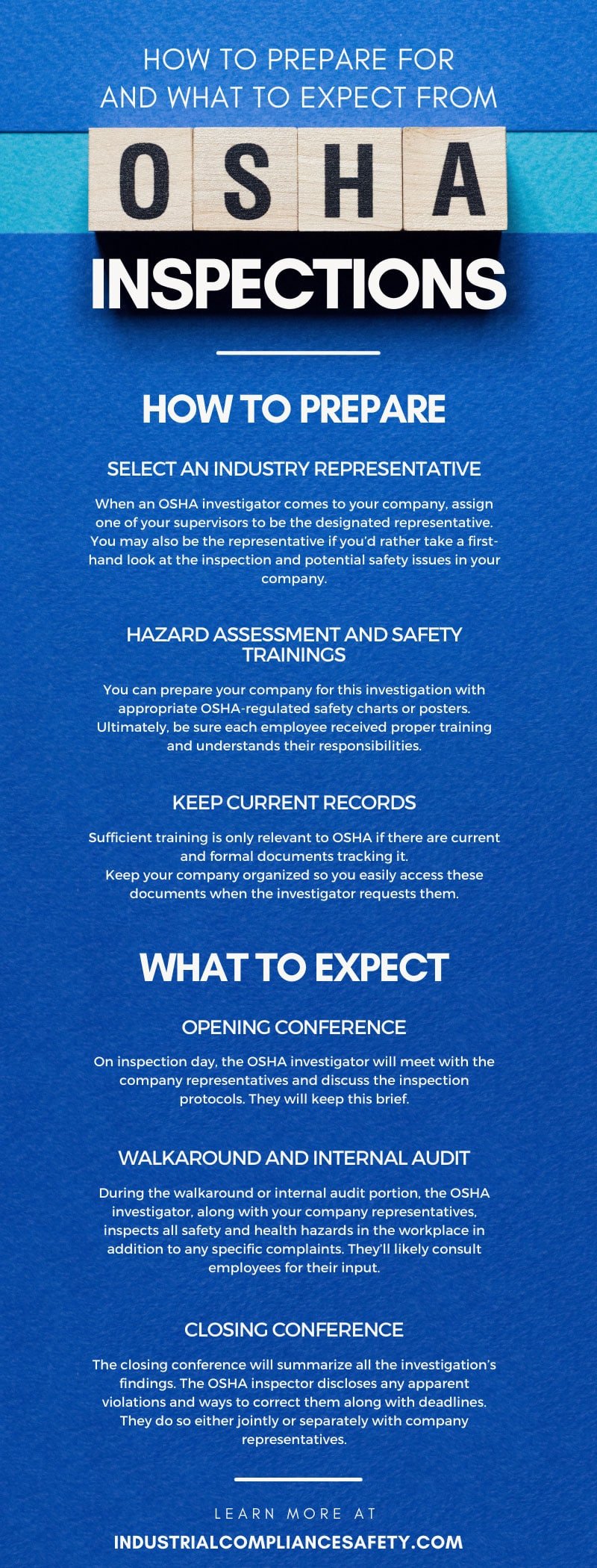The Occupational Safety and Health Administration oversees workplace safety and hazards to ensure the wellbeing of all employees. Part of their safety standards is conducting official OSHA inspections of all workplaces. Read this guide on how to prepare for and what to expect from OSHA inspections to avoid any potential workplace violations.
How To Prepare
OSHA typically conducts inspections without prior notice; however, you have the right to request an inspection warrant before they enter your workplace. You may also request an OSHA inspection whenever necessary.
Consult union representatives or co-workers before filing an official complaint. Then, complete a complaint form and fax, mail, or call OSHA with your request. This complaint notifies OSHA of an imminent safety risk that requires onsite visitation. OSHA also has the right to reject issues they deem unworthy of onsite inspection. In that case, they’ll mail a formal rejection with a list of reasons why this issue does not fit inspection criteria. If the incident seems serious, they’ll send a representative to inspect the worksite.
Select an Industry Representative
When an OSHA investigator comes to your company, assign one of your supervisors to be the designated representative. You may also be the representative if you’d rather take a first-hand look at the inspection and potential safety issues in your company. Know the location of all important documents, records, and safety trainings. Since OSHA representatives walk through the company to spot any noticeable hazards and issues, you might want to designate a secondary representative if you cannot attend. Choose someone reliable with a great understanding of the company’s practices. This will come in handy during the investigation which proves your overall safety compliance to meet OSHA standards.
Hazard Assessment and Safety Trainings
OSHA investigators primarily look for workplace safety hazards or specific issues if you or your employees filed a formal complaint. The workplace hazard analysis documents each job performed at the workplace along with their respective potential hazards. Additionally, OSHA inspectors detail ways to reduce these hazards. You can prepare your company for this investigation with appropriate OSHA-regulated safety charts or posters. Ultimately, be sure each employee received proper training and understands their responsibilities.
Keep Current Records
Sufficient training is only relevant to OSHA if there are current and formal documents tracking it.
Keep your company organized so you easily access these documents when the investigator requests them. Each worker should know where and how to access these safety documents. If not, the investigator will note that in their safety report. These documents include training records, worker compensation forms, insurance, and any internal or external audits. Correct any outstanding issues beforehand to avoid a mark on your OSHA report.
What To Expect
OSHA’s requirements and expectations must be understood. Understanding them is part of how to prepare for and what to expect from OSHA inspections. The inspection itself includes an opening conference, a walk throughout the workplace, an internal audit, and a closing conference. Investigations may take longer than a few business days is there are numerous hazards and (dis)organization. The size of the workplace is also taken into account. You have the option to request an OSHA warrant, but this is a hefty legal process that will delay the investigation.
Opening Conference
On inspection day, the OSHA investigator will meet with the company representatives and discuss the inspection protocols. They will keep this brief. However, depending on any formal complaints or if there are third-party workers at the worksite, the opening conference may take a very long time. If there are other workers outside your company at the worksite, they’ll need representatives as well. Before they begin, the OSHA inspector will check their Log and Summary of Occupational Injuries and Illnesses and other OSHA-required records.
Walkaround and Internal Audit
During the walkaround or internal audit portion, the OSHA investigator, along with your company representatives, inspects all safety and health hazards in the workplace in addition to any specific complaints. They’ll likely consult employees for their input. Remind your employees they have the right to confidentiality and may speak to the inspector privately if they wish. The inspector will wish to hear about past incidents, illnesses, and any complaints. From there, they’ll consult the representatives of these issues and conduct appropriate tests with specific devices. Ask any questions if you’re confused or uncertain of this walkthrough. Also, take detailed notes to have on hand after the inspector completes their analysis. After the inspection, conduct your own internal audits using detailed checklists to reduce future violations.
Closing Conference
The closing conference will summarize all the investigation’s findings. The OSHA inspector discloses any apparent violations and ways to correct them along with deadlines. They do so either jointly or separately with company representatives. You may face possible fines if you ignore these violations. There may also be further closing conferences to discuss test results or sampling results later on. You have the right to contest an OSHA citation but must go through the Occupational Safety and Review Commission to do so. If you agree with the citation but need more time to fix it, you may also contest the time OSHA allows you to correct them. Report any contestations within fifteen business days after the initial investigation.
Further Information
OSHA may reduce penalties for employers acting in good faith or the gravity of the violation. However, employers who have serious violations or who continue to make willful violations are subject to the full penalty. As the employer, you have the right to speak with an OSHA Area Director to discuss citations, penalties, abatement dates, or other information not detailed in the inspection. OSHA will work with you on a settlement agreement that resolves the matter and addresses the violation.
Given all that, OSHA’s goal is not to penalize you for safety hazards. Instead, they act to maintain safety compliance and correct workplace hazards for employees across industries. Alternatively, you may want to consult a third-party safety compliance company with all the OSHA information on hand to prepare yourself before your next inspection. That’s where Industrial Safety and Compliance comes in. Our Avetta® safety programs are designed to strengthen your overall safety culture. Contact us with any questions—we’re here to help you prepare!






